2017 Alfa Romeo MiTo egr
[x] Cancel search: egrPage 4 of 212
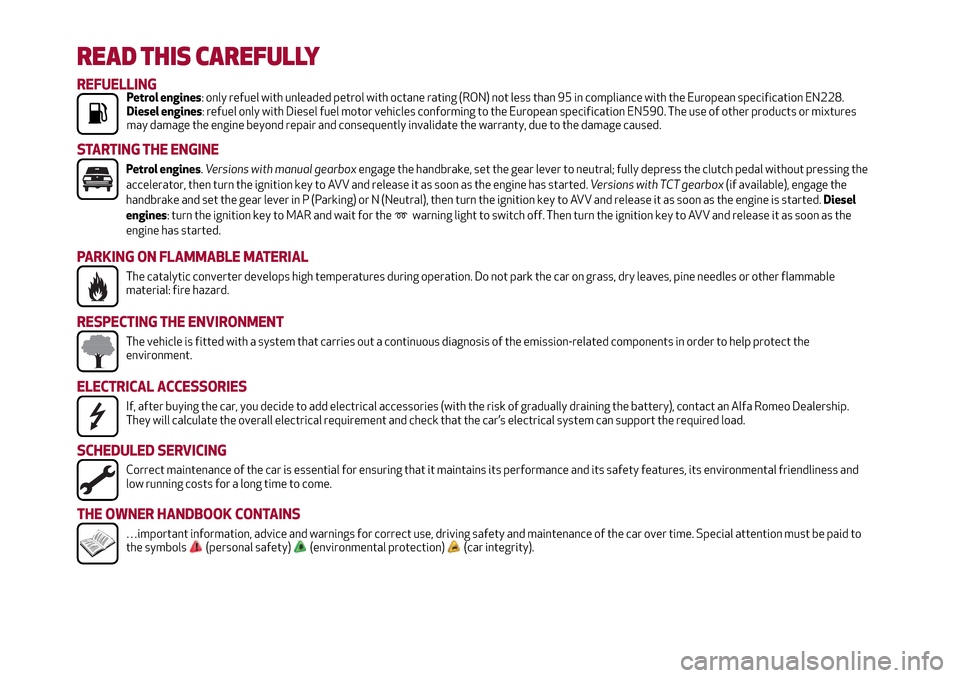
READ THIS CAREFULLY
REFUELLINGPetrol engines: only refuel with unleaded petrol with octane rating (RON) not less than 95 in compliance with the European specification EN228.
Diesel engines: refuel only with Diesel fuel motor vehicles conforming to the European specification EN590. The use of other products or mixtures
may damage the engine beyond repair and consequently invalidate the warranty, due to the damage caused.
STARTING THE ENGINE
Petrol engines.Versions with manual gearboxengage the handbrake, set the gear lever to neutral; fully depress the clutch pedal without pressing the
accelerator, then turn the ignition key to AVV and release it as soon as the engine has started.Versions with TCT gearbox(if available), engage the
handbrake and set the gear lever in P (Parking) or N (Neutral), then turn the ignition key to AVV and release it as soon as the engine is started.Diesel
engines: turn the ignition key to MAR and wait for the
warning light to switch off. Then turn the ignition key to AVV and release it as soon as the
engine has started.
PARKING ON FLAMMABLE MATERIAL
The catalytic converter develops high temperatures during operation. Do not park the car on grass, dry leaves, pine needles or other flammable
material: fire hazard.
RESPECTING THE ENVIRONMENT
The vehicle is fitted with a system that carries out a continuous diagnosis of the emission-related components in order to help protect the
environment.
ELECTRICAL ACCESSORIES
If, after buying the car, you decide to add electrical accessories (with the risk of gradually draining the battery), contact an Alfa Romeo Dealership.
They will calculate the overall electrical requirement and check that the car’s electrical system can support the required load.
SCHEDULED SERVICING
Correct maintenance of the car is essential for ensuring that it maintains its performance and its safety features, its environmental friendliness and
low running costs for a long time to come.
THE OWNER HANDBOOK CONTAINS
…important information, advice and warnings for correct use, driving safety and maintenance of the car over time. Special attention must be paid to
the symbols(personal safety)(environmental protection)(car integrity).
Page 52 of 212
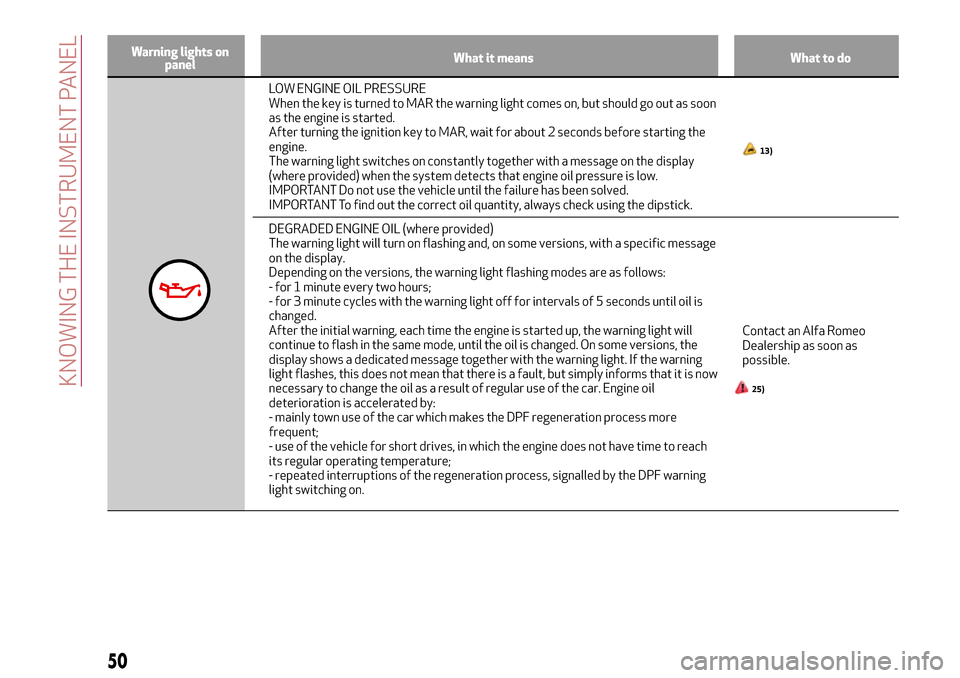
Warning lights on
panelWhat it means What to do
LOW ENGINE OIL PRESSURE
When the key is turned to MAR the warning light comes on, but should go out as soon
as the engine is started.
After turning the ignition key to MAR, wait for about 2 seconds before starting the
engine.
The warning light switches on constantly together with a message on the display
(where provided) when the system detects that engine oil pressure is low.
IMPORTANT Do not use the vehicle until the failure has been solved.
IMPORTANT To find out the correct oil quantity, always check using the dipstick.
13)
DEGRADED ENGINE OIL (where provided)
The warning light will turn on flashing and, on some versions, with a specific message
on the display.
Depending on the versions, the warning light flashing modes are as follows:
- for 1 minute every two hours;
- for 3 minute cycles with the warning light off for intervals of 5 seconds until oil is
changed.
After the initial warning, each time the engine is started up, the warning light will
continue to flash in the same mode, until the oil is changed. On some versions, the
display shows a dedicated message together with the warning light. If the warning
light flashes, this does not mean that there is a fault, but simply informs that it is now
necessary to change the oil as a result of regular use of the car. Engine oil
deterioration is accelerated by:
- mainly town use of the car which makes the DPF regeneration process more
frequent;
- use of the vehicle for short drives, in which the engine does not have time to reach
its regular operating temperature;
- repeated interruptions of the regeneration process, signalled by the DPF warning
light switching on.Contact an Alfa Romeo
Dealership as soon as
possible.
25)
50
KNOWING THE INSTRUMENT PANEL
Page 68 of 212
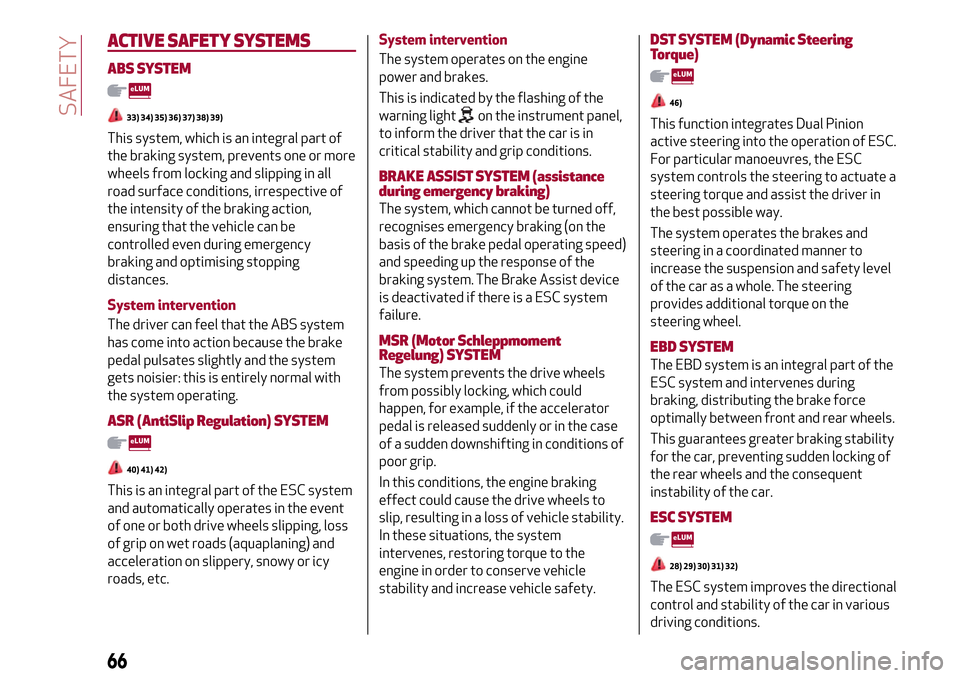
ACTIVE SAFETYSYSTEMS
ABS SYSTEM
33) 34) 35) 36) 37) 38) 39)
This system, which is an integral part of
the braking system, prevents one or more
wheels from locking and slipping in all
road surface conditions, irrespective of
the intensity of the braking action,
ensuring that the vehicle can be
controlled even during emergency
braking and optimising stopping
distances.
System intervention
The driver can feel that the ABS system
has come into action because the brake
pedal pulsates slightly and the system
gets noisier: this is entirely normal with
the system operating.
ASR (AntiSlip Regulation)SYSTEM
40) 41) 42)
This is an integral part of the ESC system
and automatically operates in the event
of one or both drive wheels slipping, loss
of grip on wet roads (aquaplaning) and
acceleration on slippery, snowy or icy
roads, etc.System intervention
The system operates on the engine
power and brakes.
This is indicated by the flashing of the
warning light
on the instrument panel,
to inform the driver that the car is in
critical stability and grip conditions.
BRAKE ASSISTSYSTEM (assistance
during emergency braking)
The system, which cannot be turned off,
recognises emergency braking (on the
basis of the brake pedal operating speed)
and speeding up the response of the
braking system. The Brake Assist device
is deactivated if there is a ESC system
failure.
MSR (Motor Schleppmoment
Regelung)SYSTEM
The system prevents the drive wheels
from possibly locking, which could
happen, for example, if the accelerator
pedal is released suddenly or in the case
of a sudden downshifting in conditions of
poor grip.
In this conditions, the engine braking
effect could cause the drive wheels to
slip, resulting in a loss of vehicle stability.
In these situations, the system
intervenes, restoring torque to the
engine in order to conserve vehicle
stability and increase vehicle safety.
DST SYSTEM (Dynamic Steering
Torque)
46)
This function integrates Dual Pinion
active steering into the operation of ESC.
For particular manoeuvres, the ESC
system controls the steering to actuate a
steering torque and assist the driver in
the best possible way.
The system operates the brakes and
steering in a coordinated manner to
increase the suspension and safety level
of the car as a whole. The steering
provides additional torque on the
steering wheel.
EBD SYSTEM
The EBD system is an integral part of the
ESC system and intervenes during
braking, distributing the brake force
optimally between front and rear wheels.
This guarantees greater braking stability
for the car, preventing sudden locking of
the rear wheels and the consequent
instability of the car.
ESC SYSTEM
28) 29) 30) 31) 32)
The ESC system improves the directional
control and stability of the car in various
driving conditions.
66
SAFETY
Page 69 of 212
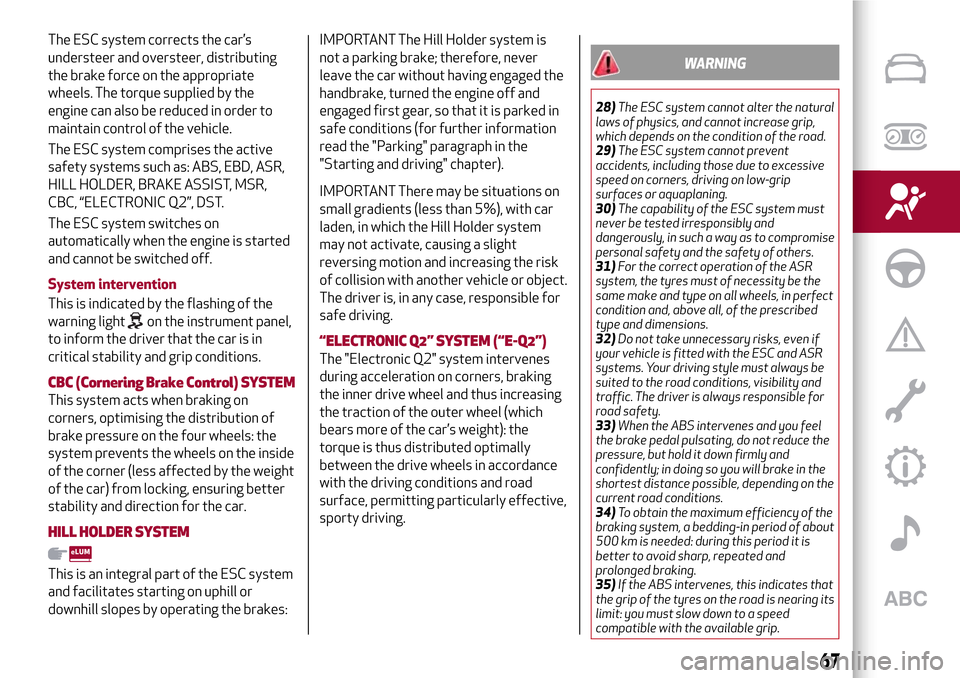
The ESC system corrects the car’s
understeer and oversteer, distributing
the brake force on the appropriate
wheels. The torque supplied by the
engine can also be reduced in order to
maintain control of the vehicle.
The ESC system comprises the active
safety systems such as: ABS, EBD, ASR,
HILL HOLDER, BRAKE ASSIST, MSR,
CBC, “ELECTRONIC Q2”, DST.
The ESC system switches on
automatically when the engine is started
and cannot be switched off.
System intervention
This is indicated by the flashing of the
warning light
on the instrument panel,
to inform the driver that the car is in
critical stability and grip conditions.
CBC (Cornering Brake Control)SYSTEM
This system acts when braking on
corners, optimising the distribution of
brake pressure on the four wheels: the
system prevents the wheels on the inside
of the corner (less affected by the weight
of the car) from locking, ensuring better
stability and direction for the car.
HILL HOLDERSYSTEM
This is an integral part of the ESC system
and facilitates starting on uphill or
downhill slopes by operating the brakes:
IMPORTANT The Hill Holder system is
not a parking brake; therefore, never
leave the car without having engaged the
handbrake, turned the engine off and
engaged first gear, so that it is parked in
safe conditions (for further information
read the "Parking" paragraph in the
"Starting and driving" chapter).
IMPORTANT There may be situations on
small gradients (less than 5%), with car
laden, in which the Hill Holder system
may not activate, causing a slight
reversing motion and increasing the risk
of collision with another vehicle or object.
The driver is, in any case, responsible for
safe driving.
“ELECTRONIC Q2”SYSTEM (“E-Q2”)
The "Electronic Q2" system intervenes
during acceleration on corners, braking
the inner drive wheel and thus increasing
the traction of the outer wheel (which
bears more of the car’s weight): the
torque is thus distributed optimally
between the drive wheels in accordance
with the driving conditions and road
surface, permitting particularly effective,
sporty driving.
WARNING
28)The ESC system cannot alter the natural
laws of physics, and cannot increase grip,
which depends on the condition of the road.
29)The ESC system cannot prevent
accidents, including those due to excessive
speed on corners, driving on low-grip
surfaces or aquaplaning.
30)The capability of the ESC system must
never be tested irresponsibly and
dangerously, in such a way as to compromise
personal safety and the safety of others.
31)For the correct operation of the ASR
system, the tyres must of necessity be the
same make and type on all wheels, in perfect
condition and, above all, of the prescribed
type and dimensions.
32)Do not take unnecessary risks, even if
your vehicle is fitted with the ESC and ASR
systems. Your driving style must always be
suited to the road conditions, visibility and
traffic. The driver is always responsible for
road safety.
33)When the ABS intervenes and you feel
the brake pedal pulsating, do not reduce the
pressure, but hold it down firmly and
confidently; in doing so you will brake in the
shortest distance possible, depending on the
current road conditions.
34)To obtain the maximum efficiency of the
braking system, a bedding-in period of about
500 km is needed: during this period it is
better to avoid sharp, repeated and
prolonged braking.
35)If the ABS intervenes, this indicates that
the grip of the tyres on the road is nearing its
limit: you must slow down to a speed
compatible with the available grip.
67
Page 75 of 212
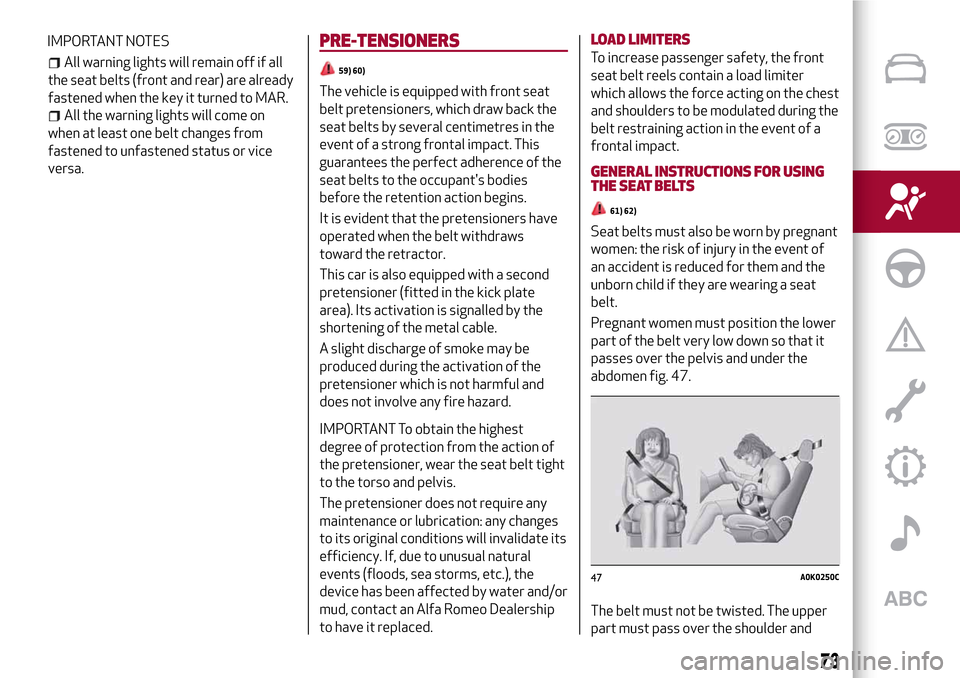
All warning lights will remain off if all
the seat belts (front and rear) are already
fastened when the key it turned to MAR.
All the warning lights will come on
when at least one belt changes from
fastened to unfastened status or vice
versa.
PRE-TENSIONERS
59) 60)
The vehicle is equipped with front seat
belt pretensioners, which draw back the
seat belts by several centimetres in the
event of a strong frontal impact. This
guarantees the perfect adherence of the
seat belts to the occupant's bodies
before the retention action begins.
It is evident that the pretensioners have
operated when the belt withdraws
toward the retractor.
This car is also equipped with a second
pretensioner (fitted in the kick plate
area). Its activation is signalled by the
shortening of the metal cable.
A slight discharge of smoke may be
produced during the activation of the
pretensioner which is not harmful and
does not involve any fire hazard.
IMPORTANT To obtain the highest
degree of protection from the action of
the pretensioner, wear the seat belt tight
to the torso and pelvis.
The pretensioner does not require any
maintenance or lubrication: any changes
to its original conditions will invalidate its
efficiency. If, due to unusual natural
events (floods, sea storms, etc.), the
device has been affected by water and/or
mud, contact an Alfa Romeo Dealership
to have it replaced.
LOAD LIMITERS
To increase passenger safety, the front
seat belt reels contain a load limiter
which allows the force acting on the chest
and shoulders to be modulated during the
belt restraining action in the event of a
frontal impact.
GENERAL INSTRUCTIONS FOR USING
THE SEAT BELTS
61) 62)
Seat belts must also be worn by pregnant
women: the risk of injury in the event of
an accident is reduced for them and the
unborn child if they are wearing a seat
belt.
Pregnant women must position the lower
part of the belt very low down so that it
passes over the pelvis and under the
abdomen fig. 47.
The belt must not be twisted. The upper
part must pass over the shoulder and
47A0K0250C
73
IMPORTANT NOTES
Page 131 of 212
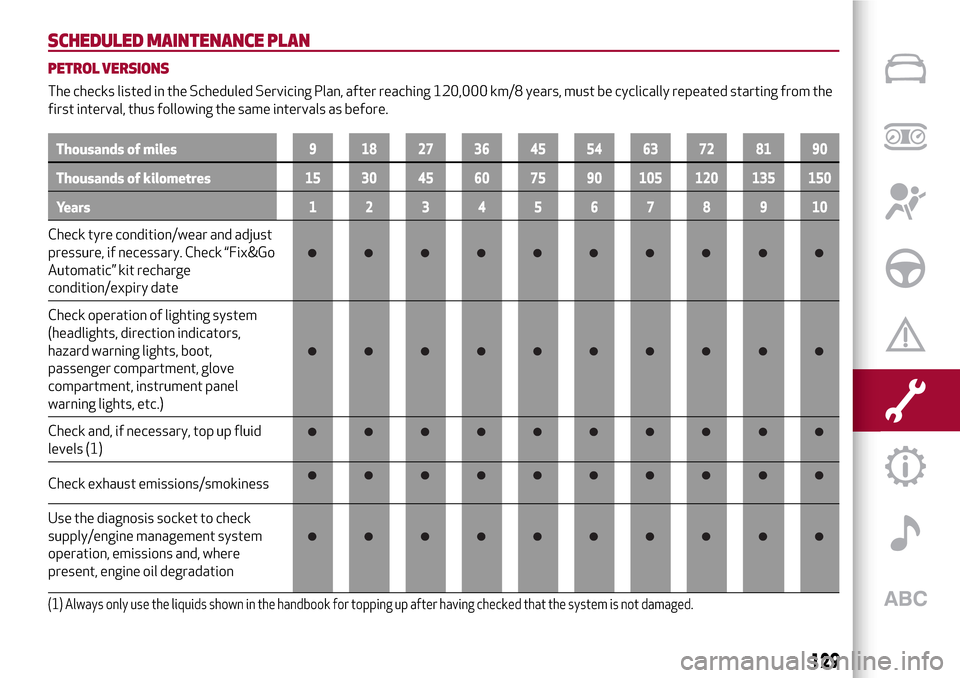
SCHEDULED MAINTENANCE PLAN
PETROL VERSIONS
The checks listed in the Scheduled Servicing Plan, after reaching 120,000 km/8 years, must be cyclically repeated starting from the
first interval, thus following the same intervals as before.
Thousands of miles9 182736455463728190
Thousands of kilometres15 30 45 60 75 90 105 120 135 150
Years12345678910
Check tyre condition/wear and adjust
pressure, if necessary. Check “Fix&Go
Automatic” kit recharge
condition/expiry date
Check operation of lighting system
(headlights, direction indicators,
hazard warning lights, boot,
passenger compartment, glove
compartment, instrument panel
warning lights, etc.)
Check and, if necessary, top up fluid
levels (1)
Check exhaust emissions/smokiness
Use the diagnosis socket to check
supply/engine management system
operation, emissions and, where
present, engine oil degradation
(1) Always only use the liquids shown in the handbook for topping up after having checked that the system is not damaged.
129
Page 135 of 212
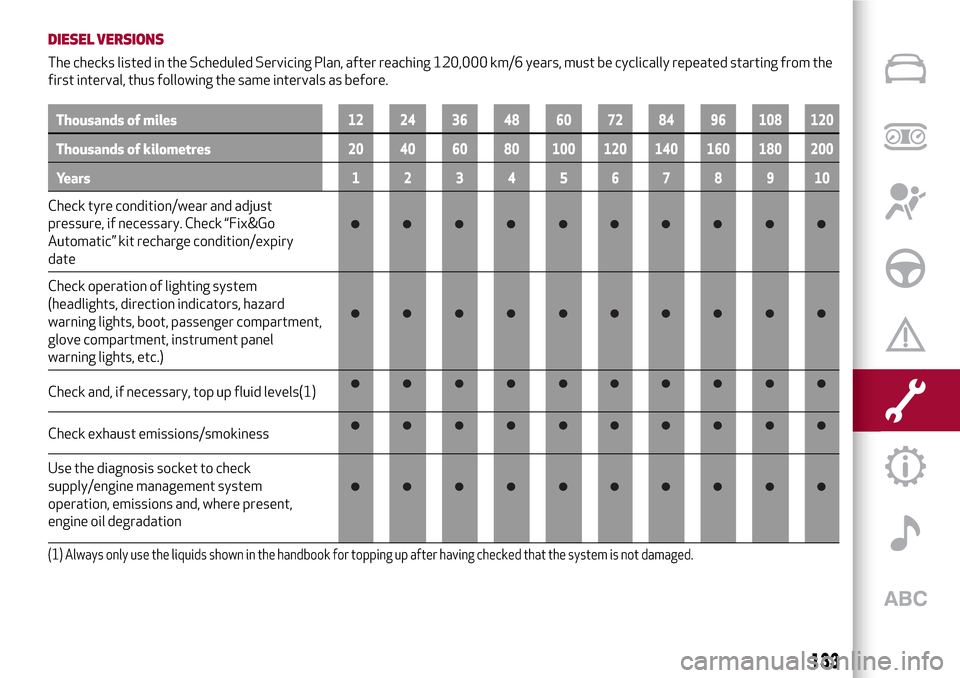
DIESEL VERSIONS
The checks listed in the Scheduled Servicing Plan, after reaching 120,000 km/6 years, must be cyclically repeated starting from the
first interval, thus following the same intervals as before.
Thousands of miles12 24 36 48 60 72 84 96 108 120
Thousands of kilometres20 40 60 80 100 120 140 160 180 200
Years12345678910
Check tyre condition/wear and adjust
pressure, if necessary. Check “Fix&Go
Automatic” kit recharge condition/expiry
date
Check operation of lighting system
(headlights, direction indicators, hazard
warning lights, boot, passenger compartment,
glove compartment, instrument panel
warning lights, etc.)
Check and, if necessary, top up fluid levels(1)
Check exhaust emissions/smokiness
Use the diagnosis socket to check
supply/engine management system
operation, emissions and, where present,
engine oil degradation
(1) Always only use the liquids shown in the handbook for topping up after having checked that the system is not damaged.
133
Page 144 of 212
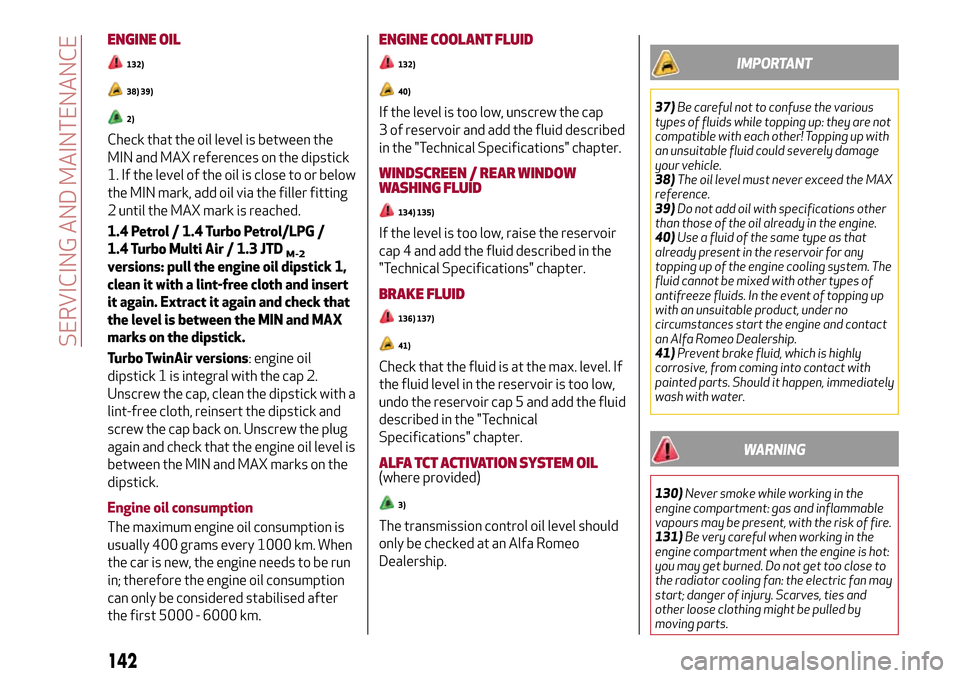
ENGINE OIL
132)
38) 39)
2)
Check that the oil level is between the
MIN and MAX references on the dipstick
1. If the level of the oil is close to or below
the MIN mark, add oil via the filler fitting
2 until the MAX mark is reached.
1.4 Petrol / 1.4 Turbo Petrol/LPG /
1.4 Turbo Multi Air / 1.3 JTD
M-2versions: pull the engine oil dipstick 1,
clean it with a lint-free cloth and insert
it again. Extract it again and check that
the level is between the MIN and MAX
marks on the dipstick.
Turbo TwinAir versions: engine oil
dipstick 1 is integral with the cap 2.
Unscrew the cap, clean the dipstick with a
lint-free cloth, reinsert the dipstick and
screw the cap back on. Unscrew the plug
again and check that the engine oil level is
between the MIN and MAX marks on the
dipstick.
Engine oil consumption
The maximum engine oil consumption is
usually 400 grams every 1000 km. When
the car is new, the engine needs to be run
in; therefore the engine oil consumption
can only be considered stabilised after
the first 5000 - 6000 km.
ENGINE COOLANT FLUID
132)
40)
If the level is too low, unscrew the cap
3 of reservoir and add the fluid described
in the "Technical Specifications" chapter.
WINDSCREEN / REAR WINDOW
WASHING FLUID
134) 135)
If the level is too low, raise the reservoir
cap 4 and add the fluid described in the
"Technical Specifications" chapter.
BRAKE FLUID
136) 137)
41)
Check that the fluid is at the max. level. If
the fluid level in the reservoir is too low,
undo the reservoir cap 5 and add the fluid
described in the "Technical
Specifications" chapter.
ALFA TCT ACTIVATIONSYSTEM OIL(where provided)
3)
The transmission control oil level should
only be checked at an Alfa Romeo
Dealership.
IMPORTANT
37)Be careful not to confuse the various
types of fluids while topping up: they are not
compatible with each other! Topping up with
an unsuitable fluid could severely damage
your vehicle.
38)The oil level must never exceed the MAX
reference.
39)Do not add oil with specifications other
than those of the oil already in the engine.
40)Use a fluid of the same type as that
already present in the reservoir for any
topping up of the engine cooling system. The
fluid cannot be mixed with other types of
antifreeze fluids. In the event of topping up
with an unsuitable product, under no
circumstances start the engine and contact
an Alfa Romeo Dealership.
41)Prevent brake fluid, which is highly
corrosive, from coming into contact with
painted parts. Should it happen, immediately
wash with water.
WARNING
130)Never smoke while working in the
engine compartment: gas and inflammable
vapours may be present, with the risk of fire.
131)Be very careful when working in the
engine compartment when the engine is hot:
you may get burned. Do not get too close to
the radiator cooling fan: the electric fan may
start; danger of injury. Scarves, ties and
other loose clothing might be pulled by
moving parts.
142
SERVICING AND MAINTENANCE